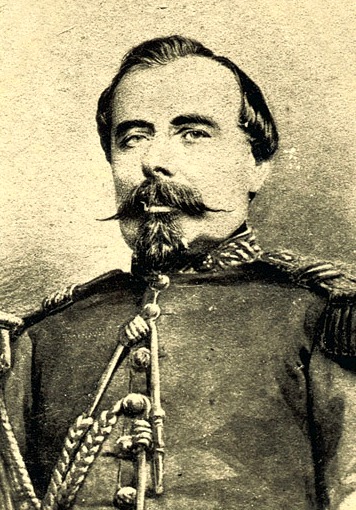Francisco Bolognesi
| This article includes a list of references, related reading or external links, but its sources remain unclear because it lacks inline citations. Please improve this article by introducing more precise citations where appropriate. (June 2009) |
| This article relies largely or entirely upon a single source. Please help improve this article by introducing appropriate citationsto additional sources. (June 2009) |
| Francisco Bolognesi | |
|---|---|
 Peruvian hero during the War of the Pacific | |
| Born | November 4, 1816 Lima, Lima, Peru |
| Died | June 7, 1880 (aged 63) Arica, Peru (now Chile) |
Francisco Bolognesi Cervantes (1816-1880) was aPeruvian military hero. He is considered national hero in Peru and was declared patron of the Army of Peru by the government of Peru on January 2 of 1951.
Contents[hide] |
[edit]Early life and education
Francisco Bolognesi was born in Lima on November 4, 1816. He attended the Seminary of Arequipa until he was 16 and then entered into a career in commerce.
His father, Andrés Bolognesi was of Italian-Peruvianbackground and was a violin player for the court of theViceroy. Francisco Bolognesi had a son called Mariano who gave birth to Federico Bolognesi (2nd Vicepresident of Peru). Federico Bolognesi had a daughter called Ana Maria Bolognesi who had two daughters called Ana Mamie and Selina Raguz Bolognesi.
[edit]Military career
He was involved with the military in July, 1844, in an action at Carmen Alto, a local district of Arequipa. While offered a position in the military, he elected to remain in civilian life. However, in 1853, he enlisted and was selected as second in command of a cavalry regiment during a period of tension between Peru and Bolivia. While no armed conflict with Bolivia ensued, Bolognesi elected to remain in the military and took part in the revolution against then-President Echenique. After the successful revolution, Bolognesi was a Lieutenant Colonel on the General Staff.
In 1856, Bolognesi commanded the artillery involved in suppressing the revolt of General Manuel Ignacio de Vivanco, centered in the city of Arequipa, and was promoted to Colonel.
After several missions to Europe to help acquire weapons for Peru (especially artillery), Bolognesi returned to Peru in May 1866. He fell afoul of President Don Mariano Ignacio Prado and was imprisoned briefly in 1867. After the fall of Prado, Bolognesi returned to military service, commanding various artillery units of the Peruvian army, retiring in 1871 as Commander-in-Chief of the Artillery.
[edit]War of the Pacific
When the War of the Pacific began in 1879 between Chile and the alliance of Peru andBolivia, Bolognesi, now 62, rejoined the Peruvian Army and was active in actions against the Chilean forces, including theBattles of Dolores and Tarapacá in November, 1879. In April, 1880, he was placed in command of the Peruvian port ofArica.
He commanded the Peruvian forces surrounded in Arica by Chilean troops following the Chilean victory at Tacna. He organized and led a spirited defense of the port city by about 1,600 men against over 5,300 Chilean troops with extensive naval support.
When Chilean messengers demanded surrender of Arica because of their 3 to 1 numerical superiority, he replied, "Tengo deberes sagrados que cumplir y los cumpliré hasta quemar el último cartucho" ("I have sacred duties to fulfill, and I will fulfill them until I fire the last round"). The expression "hasta quemar el último cartucho" ("Until the last round is fired") has passed into the Spanish language.
On June 7, 1880, a Chilean assault took Arica at a cost of 474 troops. Almost 1,000 of the Peruvian defenders, including Colonel Bolognesi, were killed in defense of the town.
Bolognesi's sons Enrique and Augusto also fought in the War of the Pacific, and died later, during the Battle of San Juan and the Battle of Miraflores in Lima.


No hay comentarios :
Publicar un comentario